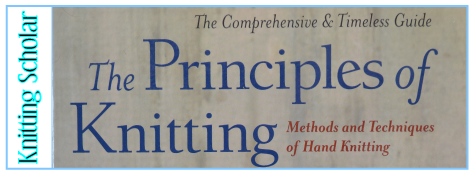(I know, it’s almost two months since this came out, but it’s BIG, guys! Thanks for being so patient for the review.)
First, the facts:
Author: June Hemmons Hiatt
Published by: Touchstone, 2012
Pages: 736
Type: How-to, Reference
Chapters:
1. Learning and Methods
2. Constructing a Fabric
3. Decorative Techniques
4. Special Fabrics
5. Stitch and Color Patterns
6. Pattern Design
7. Materials
8. Working a Project
The In-Depth Look:
Settle in–this is going to be a long story.
Principles of Knitting is one of the holy grails of the knitting world. A book so hard to find, yet so wonderful, that collectors go charging (their credit cards) to the ends of the earth to get their hands on a copy.
The amazing thing is that many of the people working that hard to find it, had never even seen a copy. It somehow flew under my book-radar when it came out in 1989, because I didn’t even remember having seen it when I started hearing the buzz about how this was the be-all and end-all of knitting encyclopedias. (The Alice Starmore books had much the same mythical appeal, but at least I remember having seen those in the bookstores when I was in college–I just didn’t have the spending money to buy them at the time, though I kicked myself for decades.)
Rumor had it that Principles of Knitting was perfection in print. That it covered absolutely everything, in great detail. That it was the only knitting book you would ever need. That it was worth every penny of the $200+ it usually cost to buy it. But then there were other rumors that the author was too opinionated. That she had her preferred methods and anybodey who didn’t follow them was simply wrong. That she pretty much ignored the methods she didn’t like.
Who knew if that was true, though? With copies long-since pilfered from local libraries, it wasn’t like anybody could actually check–unless you had a far-sighted friend who’d bought a copy when she had a chance.
Then, more rumors started whispering–that the author was updating the book. This rumor lasted for years. Every time it came up with a “I heard it’s coming next year,” the calendar would change and still, there’d be no book. Finally, it showed up on Amazon.com as available for pre-order, which was a good sign, but the expected date kept getting pushed back. And pushed back. And back again.
All of which is by way of saying that the new Principles of Knitting is HERE. And looking at it, I can see exactly why it took so long.
First, the book is HUGE. (See scale photo of it sitting with several other books in my review pile. There is simply no comparison.)
How big, you ask? 736 pages. Seven hundred thirty six. That’s 300 pages more than Alden Amos’ Big Book of Handspinning. 500 more than Vogue Knitting’s Ultimate Knitting Book. 200 pages more than the biggest cookbook in my collection (Shirley Corriher’s Cookwise). There simply is no comparison to any other book in my library, not even Harry Potter and the Deathly Hallows which might have more pages, but they’re smaller and not so densely packed.
Because, these pages are densely packed. This truly is encyclopedic in its scope because the author tries to fit in, well, everything. There are a lot of knitting techniques now that weren’t around when she wrote this book back in the 80s. (Magic Loop and knitting with two-circulars spring to mind, just to name a couple techniques.)
I can’t even begin to pretend that I’ve read this entire thing (yet). I’ve read SOME of it, certainly, and I plan to read all of it, but it’s going to take a while. (Did I mention this is a rather large book?)
So, after that lengthy introduction, what follows is a light touch on some specifics.
Ultimately, this book is something of a masterpiece. I’m nowhere near done reading it yet–I think I’m about at the 20% mark on my Kindle–but I’ve already seen references to techniques I hadn’t known before. Or had only heard about. It was well worth buying. Twice.
You can get yours from Amazon in Paper or as an eBook.
Want to see bigger pictures? Click here.



